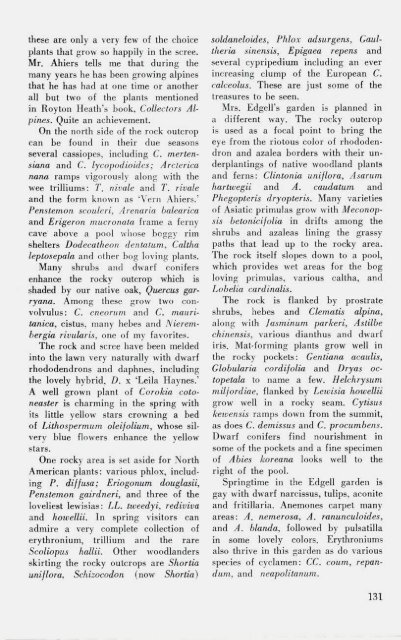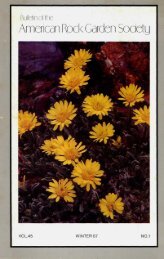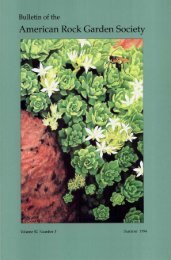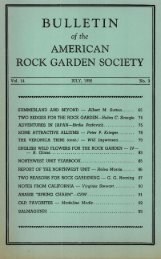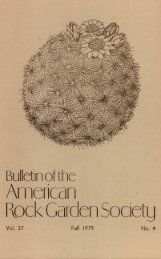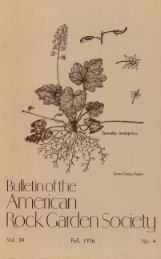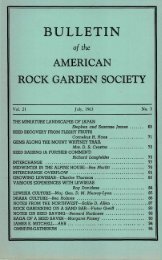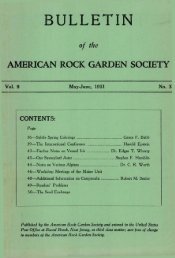Bulletin - Summer 1979 - North American Rock Garden Society
Bulletin - Summer 1979 - North American Rock Garden Society
Bulletin - Summer 1979 - North American Rock Garden Society
You also want an ePaper? Increase the reach of your titles
YUMPU automatically turns print PDFs into web optimized ePapers that Google loves.
these are only a very few of the choiceplants that grow so happily in the scree.Mr. Ahiers tells me that during themany years he has been growing alpinesthat he has had at one time or anotherall but two of the plants mentionedin Royton Heath's book, Collectors Alpines.Quite an achievement.On the north side of the rock outcropcan be found in their due seasonsseveral cassiopes, including C. mertensianaand C. lycopodioidcs; Arctericanana ramps vigorously along with thewee trilliums: T. nivale and T. rivaleand the form known as 'Vern Ahiers.'Penslemon scouleri, Arenaria halearicaand Erigeron mucronata frame a fernycave above a pool whose boggy rimshelters Dodecatheon dentalum, Calthaleptosepala and other bog loving plants.Many shrubs and dwarf conifersenhance the rocky outcrop which isshaded by our native oak, Quercus garryana.Among these grow two convolvulus:C. cneorum and C. mauritanica,cistus, many hebes and Nieremhergiarivularis, one of my favorites.The rock and scree have been meldedinto the lawn very naturally with dwarfrhododendrons and daphnes, includingthe lovely hybrid, D. x 'Leila Haynes.'A well grown plant of Corokia cotoneasteris charming in the spring withits little yellow stars crowning a bedof Lithospermum oleifolium, whose silveryblue flowers enhance the yellowstars.One rocky area is set aside for <strong>North</strong><strong>American</strong> plants: various phlox, includingP. diffusa; Eriogonum douglasii,Penstemon gairdneri, and three of theloveliest lewisias: LL. tweedyi, redivivaand howellii. In spring visitors canadmire a very complete collection oferythronium, trillium and the rareScoliopus hallii. Other woodlandersskirting the rocky outcrops are Shortiauniflora, Schizocodon (now Shortia)soldaneloides, Phlox adsurgens, Gaultheriasinensis, Epigaea repens andseveral cypripedium including an everincreasing clump of the European C.calceolus. These are just some of thetreasures to be seen.Mrs. Edgell's garden is planned ina different way. The rocky outcropis used as a focal point to bring theeye from the riotous color of rhododendronand azalea borders with their underplantingsof native woodland plantsand ferns: Clintonia uniflora, Asarumhartwegii and A. caudatum andPhegopteris dryopteris. Many varietiesof Asiatic primulas grow with Meconopsisbetonicifolia in drifts among theshrubs and azaleas lining the grassypaths that lead up to the rocky area.The rock itself slopes down to a pool,which provides wet areas for the bogloving primulas, various caltha, andLobelia cardinalis.The rock is flanked by prostrateshrubs, hebes and Clematis alpina,along with Jasminum parkeri, Astilbechinensis, various dianthus and dwarfiris. Mat-forming plants grow well inthe rocky pockets: Gentiana acaulis,Globularia cordifolia and Dryas octopetalato name a few. Helchrysummiljordiae, flanked by Lewisia howelliigrow well in a rocky seam. Cytisuskewensis ramps down from the summit,as does C. demissus and C. procumbens.Dwarf conifers find nourishment insome of the pockets and a fine specimenof Abies koreana looks well to theright of the pool.Springtime in the Edgell garden isgay with dwarf narcissus, tulips, aconiteand fritillaria. Anemones carpet manyareas: A. nemerosa, A. ranunculoides,and A. blanda, followed by pulsatillain some lovely colors. Erythroniumsalso thrive in this garden as do variousspecies of cyclamen: CC. coum, repandum,and neapolitanum.131


